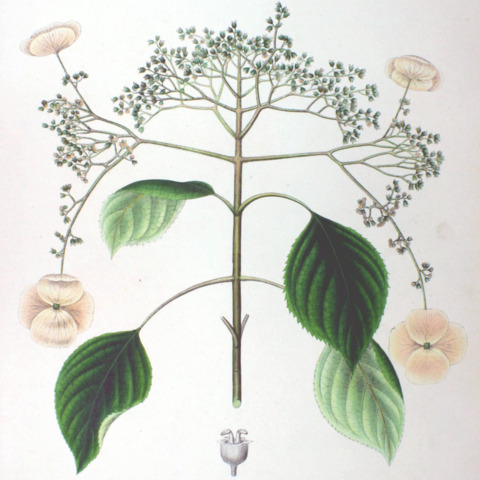Shrubs climbing, 2-4 m tall or more. Branchlets gray-brown, robust, glabrous; bark thin, loose, peeled off into fragments when old. Petiole 2-8 cm, glabrous or pilose; leaf blade yellow-brown on both surfaces when dry, elliptic, oblong-ovate, or ovate, 6-17 × 3-10 cm, papery, both surfaces glabrous or abaxially sometimes sparsely brownish pubescent along veins and barbate at vein axils, secondary veins 6-8 on both sides of midvein, abaxially prominent, base cuneate, subrounded, or sometimes shallowly cordate, margin densely serrulate, apex acuminate. Inflorescences corymbose cymes, to 30 cm wide in fruit, pubescent, apex arcuate. Sterile flowers with sepals 4, broadly obovate to suborbicular, 1-2.2 × 1-2.2 cm, margin entire except for a few obtuse teeth. Fertile flowers with calyx tube campanulate, 1-1.5 mm; teeth broadly ovate to triangular, 0.5-0.8 mm. Petals apically connate and forming a calyptra, apex rounded to subacute. Stamens 9-18, subequal; anthers subglobose, small. Ovary inferior. Styles 2(or 3), recurved, ca. 1.5 mm in fruit. Capsule urn-shaped, 3-4.5 mm in diam., apex truncate. Seeds brownish, ellipsoid to oblong, compressed, 0.7-1 mm; wing encircling seed. Fl. May-Jun, fr. Sep-Oct.
More
A shrub or vine. It loses its leaves during the year. It grows 12 m high. The stem is stout and twining. The leaves are oval or sword shaped. They are bright green with teeth along the edge. The flowers are yellowish white. They occur in rounded clusters.
Shady ravines to 2100 metres in the Himalayas. Dense to sparse forests in valleys, along stream banks, or on rocky mountain slopes at elevations of 500-2900 metres.
More
A temperate plant. It needs rich, moist soils. It needs a protected sunny position. It is resistant to frost but sensitive to drought.

